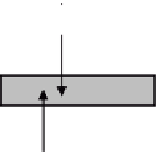Biomedical Engineering Reference
In-Depth Information
D
P
v
A
d
h
τ
π
D
d
h
(P
v
+d
P
v
)A
ρ
Ag
d
h
FIGURE 12.8
Force balance on an element of storage silo.
where K is the Janssen coefficient. For liquids, the pressure is uniform in all
directions, so K is 1.0. This relation is not strictly valid for all solids, but for
engineering approximations we can start with this assumption.
Substituting
Eqs. (12.5)
and
(12.6)
in
Eq. (12.4)
, we get:
A dP
v
5
ρ
Ag dh
2
k
f
KP
v
π
D dh
(12.7)
Boundary conditions for this equation are h
0, P
v
5
0; h
H, P
v
5
P
0
.
5
5
With this,
Eq. (12.7)
is integrated from h
H to get the pressure at
the base of the silo's vertical section, P
0
. Substituting
0toh
5
5
5
π
D
2
4
A
we get
P
0
5
ρ
Dg
4k
f
K
4Hk
f
K
D
1
exp
(12.8)
2
2
This is known as the Janssen equation.
Figure 12.7
illustrated the pressure distribution along the height of a silo.
The straight line shows the pressure we expect if the stored substance is a
liquid; the discontinuous exponential curve is the one predicted for solids.
There is a sharp increase in pressure at the beginning of the inclined wall.
The pressure decreases with height (
Figure 12.7
).
The stress on the inclined section is different from that calculated from
the preceding. To calculate this, we use the Jenike equation, which states
that the radial pressure is proportional to the distance of the element from
the hopper apex, which is the point where inclined surfaces would meet if
they were extended (Jenike, 1964). It can be seen that the magnitude of
stress at the hopper exit is the lowest, although this is the lowest point in the
hopper.















Search WWH ::

Custom Search